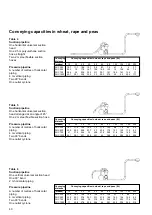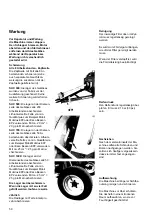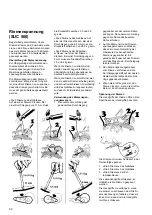
Conveying Capacity
The conveying capacity depends
on the piping layaut and the type of
material to be conveyed.
In the examples the conveying
capacities apply to materials with
the following specific gravities:
Specific gravity
Material kg/m
3
Barley .......................................670
Wheat .......................................750
Oats ..........................................500
Rye ...........................................700
Maize ........................................700
Rape .........................................700
Peas .........................................800
The capacities are based on pre-
cleaned material with a moisture
content of 15% (grain, maize and
peas) or 9% (rape). Unclean crops
and higher moisture contents will
reduce the capacities.
The tables on page 14 show the
conveying capacities for barley, rye,
oats and maize with three different
types of standard suction pipelines
and one standard pressure pipe-
line. The tables on page 15 show
corresponding capacities for wheat,
rape and peas.
Each table gives the capacities of
the different blower sizes at dif-
ferent conveying distances.
The conveying distance is the total
length of all horizontal and vertical
piping on the suction and pressure
side. The length of suction hose
is included, but bends and suction
head are not taken into account.
If a long suction head is used, the
conveying distance must be in-
creased by 1.5 m. For each exten-
sion there will be a further increase
of 0.65 m.
Pneumatic conveying is based on
the use of atmospheric air to carry
the crops through the pipelines.
Thus factors influencing the air
condition (temperature, barometric
pressure) will also effect the con
-
veying capacity. The capacities
shown are based on a barometric
pressure of approx. 760 mm Hg
and an air temperature of 20 C.
The examples given are only in-
tended as a guide as many other
factors may affect the capacity.
Conveying capacities in barley, rye, oats
and maize
Table 1
Suction pipeline
One horizontal universal suction head
One 2.5 m polyurethane suction hose, straight
Two 2 m steel flexible suction hoses
Pressure pipeline
A number of metres of horizontal piping
4 m vertical piping
Two 90° bends
One outlet cyclone
Table 2
Suction pipeline
One horizontal universal suction head arranged at an angle of 45°
One 2 m steel flexible suction hose
Pressure pipeline
A number of metres of horizontal piping
4 m vertical piping
Two 90° bends
One outlet cyclone
Table 3
Suction pipeline
One vertical universal suction head
One 90° bend
2 m horizontal piping
Pressure pipeline
A number of metres of horizontal piping
4 m vertical piping
Two 90° bends
One outlet cyclone
Conveying
Conveying capacities in barley, rye, oats and maize (t/h)
distance
(metres)
10 20 30 40 50 60 80 100 120 150 200
SUC
300 14 12.9 11.9 11 10.2 9.5 8.3 7.2 6.4 5.3 4
SUC
500 22.5 20.9 19.6 18.3 17.2 16.2 14.4 13 11.7 10.1 8.1
SUC
700 29.5 27.6 26 24.5 23.1 21.8 19.7 17.8 16.3 14.3 11.8
SUC
1000 45.1 42.1 39.4 37.1 34.9 33 29.7 27 24.7 21.8 18.2
Conveying
Conveying capacities in barley, rye, oats and maize (t/h)
distance
(metres)
10 20 30 40 50 60 80 100 120 150 200
SUC
300 19.6 17.7 16 14.6 13.3 12.3 10.5 9 7.8 6.4 4.7
SUC
500 31.8 28.9 26.5 24.4 22.6 21 18.3 16.1 14.3 12.2 9.5
SUC
700 42.1 38.6 35.5 32.9 30.6 28.6 25.1 22.4 20.1 17.3 13.9
SUC
1000 65.8 59.6 54.5 50.1 46.6 43.1 37.8 33.5 30.1 26 21.1
Conveying
Conveying capacities in barley, rye, oats and maize (t/h)
distance
(metres)
10 20 30 40 50 60 80 100 120 150 200
SUC
300 21 18.8 16.9
15.4 14 12.8 10.9 9.3 8.1 6.6 4.8
SUC
500 34.2 30.9 28.2 25.8 23.8 22 19.1 16.8 14.9 12.6 9.8
SUC
700 45.5 41.4 37.9 35 32.4 30.1 26.3 23.3 20.9 17.9 14.3
SUC
1000 74.3 66.6 60.3 55 50.6 46.8 40.6 35.7 31.9 27.4 22






























